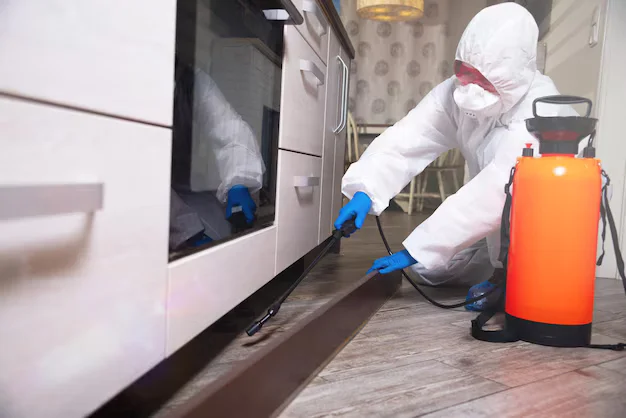Termites are one of the most destructive pests a homeowner or business owner can encounter. These tiny insects work silently but can cause extensive structural damage before they’re even detected. Unlike other pests that may simply be a nuisance, termites feed on wood and other materials, weakening foundations, walls, and support beams. Without proper termite control, the damage can be severe, often leading to costly repairs.
Understanding how termites operate, recognizing early warning signs, and implementing effective prevention strategies can help protect properties from infestation. Taking proactive measures ensures that structures remain strong and secure for years to come.
The Hidden Danger of Termites
Unlike rodents or insects that are easy to spot, termites often go unnoticed until significant damage has been done. Their ability to stay hidden makes them particularly dangerous.
1. How Termites Cause Damage
✔ Termites feed on cellulose, which is found in wood, drywall, and even paper products.
✔ They create tunnels within structures, weakening walls, floors, and ceilings.
✔ Infestations can compromise a building’s structural integrity, leading to safety risks.
2. The Cost of an Untreated Infestation
✔ Homeowners spend billions of dollars each year on termite damage repairs.
✔ Insurance policies typically do not cover termite-related damage.
✔ Early detection and professional termite control services can prevent costly renovations.
Without timely intervention, even a small termite colony can wreak havoc on a property.
Signs of a Termite Infestation
Termites work behind walls and beneath floors, making detection difficult. However, there are a few key warning signs that indicate their presence.
✔ Mud Tubes: These small, dirt-colored tunnels on walls and foundations help termites stay hidden while they move.
✔ Hollowed or Damaged Wood: Wood that sounds hollow when tapped may be compromised.
✔ Discarded Wings: Termites shed their wings after finding a new nesting site, leaving small piles near doors and windows.
✔ Frass (Termite Droppings): Small piles of wood-colored pellets indicate an active infestation.
✔ Warped or Bubbling Paint: Moisture buildup from termite tunnels can cause walls to appear distorted.
Recognizing these signs early can prevent severe structural damage.
The Different Types of Termites
Not all termites behave the same way, and different species require different treatment methods.
1. Subterranean Termites
✔ The most common and destructive type, found in underground colonies.
✔ Build mud tunnels to access wood above ground.
✔ Require moisture to survive, often found in damp environments.
2. Drywood Termites
✔ Infest dry wood and don’t require soil contact.
✔ Found in attics, furniture, and wooden beams.
✔ Create extensive tunnel systems inside wood structures.
3. Dampwood Termites
✔ Attracted to moist or decaying wood.
✔ Less common in homes but can cause damage in humid areas.
✔ Typically infest logs, stumps, and wet wood near foundations.
Identifying the type of termite infestation helps determine the best course of treatment.
Termite Control Methods
Effective termite control involves a combination of preventative measures and professional treatments.
1. Chemical Treatments
✔ Liquid termiticides create a protective barrier around the home.
✔ Baiting systems attract termites and eliminate colonies over time.
✔ Direct wood treatments prevent infestations in vulnerable areas.
2. Termite Stations
✔ Designed to monitor and control termite populations.
✔ Placed around a property to detect early termite activity.
✔ Slow-acting bait lures termites, reducing colony size gradually.
3. Fumigation
✔ Used for severe infestations in drywood termite cases.
✔ Treats entire structures to eliminate active colonies.
✔ Requires professional handling and safety precautions.
4. Preventative Maintenance
✔ Reducing moisture around the foundation discourages termite activity.
✔ Keeping firewood, mulch, and untreated lumber away from the home minimizes risk.
✔ Regular inspections help catch early warning signs before an infestation spreads.
A combination of these strategies provides long-term protection against termites.
The Role of Professional Termite Control Services
While DIY methods may help with minor pest issues, termite infestations require professional expertise.
✔ Thorough Inspections: Professionals can detect termite activity in hidden areas.
✔ Customized Treatment Plans: Different properties and termite species require tailored solutions.
✔ Long-Term Protection: Ongoing monitoring and treatments prevent future infestations.
Pest Solutions Plus provides expert termite control services to help homeowners and businesses safeguard their properties. With professional assistance, property owners can ensure effective, long-lasting protection against termites.
How to Prevent Future Termite Infestations
Once termites have been eliminated, preventing future infestations is crucial for long-term property protection.
✔ Maintain Proper Drainage: Ensure gutters and downspouts direct water away from the foundation.
✔ Seal Entry Points: Close gaps and cracks in walls, doors, and windows.
✔ Use Treated Wood: If building or renovating, opt for termite-resistant materials.
✔ Limit Wood-to-Ground Contact: Keep wooden structures, decks, and fences elevated off the soil.
✔ Schedule Annual Inspections: Professional monitoring ensures early detection of potential problems.
By implementing these strategies, homeowners and businesses can keep their properties termites-free.
Conclusion
Termite control is essential for protecting homes and businesses from costly structural damage. These silent destroyers can compromise the integrity of buildings, making early detection and professional treatment crucial. Understanding the signs of infestation, the different termites species, and the best prevention methods helps property owners take proactive measures.
With regular inspections, termite stations, and preventative maintenance, long-term termites protection is achievable. Investing in professional pest control services ensures peace of mind and safeguards a property’s value for years to come.







